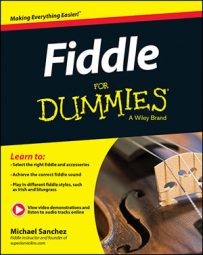The most important thing to master in a song when playing the fiddle is the notes, but a close second is the rhythm. If you’re just playing notes randomly and not counting properly, your songs won’t sound as good as they could, and you’ll have a hard time playing with others.
Using a metronome
A metronome is a very useful device that helps to keep meter in a musical piece. There are many different metronomes out there, but all of them serve the same purpose — to help you count and keep proper meter.
Each metronome has a function that clicks when prompted. Every metronome has the option to change the speed of the beat, but the way you change the speed may not be the same. The speed of the clicks depends on the number of BPM (beats per minute) that you set.
A good speed to set your metronome to first learn a piece is around 40 to 60 BPM. Many fiddle pieces are played much faster than this, but you have to first learn a piece slowly in order to play it fast later. Performance speed for beginner fiddle players is around 80 BPM.
Make sure that the metronome is set at the quarter-note setting. It may have an eighth-note setting or other rhythms you haven’t learned yet, but don’t use these settings until you build more skill.
If you have the metronome set on 60 BPM but you have it on the eighth-note setting, it will actually be the same as if you had it on 120 BPM for a quarter note (double)! If you set the metronome around 60 BPM and it doesn’t sound close to a second hand, it’s on the wrong setting.
Think about all the numbers that represent each of the notes you’ve been working with. Every metronome click is considered one beat, so if you see a half note, you should wait for two clicks before you go on to the next note. If you see two eighth notes, you should play them within one metronome click.
Tapping your foot
When you’re playing fiddle, you won’t always have your metronome around to help. Not to mention you probably wouldn’t want to perform for people when they can hear a loud click-click-click! The key is to use the metronome as much as you need and then use other methods of counting to help you.
One such method is tapping your foot. This can work well when you’re playing a song and you want to keep that nice meter from beat to beat. You can tap your foot throughout an entire song or just during the parts where you feel you need help with the counting. If you’re a newer player, you’ll want to toe tap or use the metronome almost all the time or your rhythm will be off.
Some less coordinated people may have trouble tapping their foot without a metronome. With everything going on with the fiddle, including different rhythms, notes, and techniques, the tapping may be too much for a beginner player to handle. If this describes you, just use the metronome as much as possible. Eventually, that beat will be ingrained in your head and you’ll be able to tap your foot properly.
You may have trouble counting eighth notes because you have to fit two notes into one tap/metronome click. If you’re having trouble with the eighth notes, go back to the basics and count them with the metronome. See whether you can clap steadily and hit every click on every other eighth note.
Playing at the right speed
Playing a piece around 40 BPM is a good general place to start, but your speed really depends on the difficulty of the piece. You don’t want to play something too fast, either, as that can sacrifice the song’s tone quality.
In many songs, you’ll see tempo suggestions, which tell you how fast you should perform a piece. If a piece is written to be played fast, you won’t always be able to play it fast enough, but it’s something that you can always work toward.
At the beginning of a piece and typically in the top-left corner, you’ll see what’s called a tempo marking. Check out “Arkansas Traveler,” which is made to be played at a fast speed.
![[Credit: Figure by Michael Sanchez]](https://www.dummies.com/wp-content/uploads/459254.image0.jpg)
Do you see that the song is marked Allegro? This indicates that the piece is supposed to be played very fast. This tempo marking suggests that a piece be played between 84 and 144 BPM.
If you’re more of a beginner, you should stick to the very bottom of the suggested tempo markings. If you’re more advanced, you may want to work up to the suggested tempo marking — even the highest end of it if you think you can do it!
Here’s a list of some common tempo markings in music that you may see:
Largo: 42 to 66 BPM
Andante: 56 to 88 BPM
Moderato: 66 to 126 BPM
Allegro: 84 to 144 BPM
There are more than 20 tempo markings, so if you see others that aren’t listed here, you can always look them up online.
Don’t let your technique suffer because you’re trying to play a song too fast. A lot of times when you try to do this, you’ll start missing notes and you’ll start gripping the bow too hard.
If you’re playing a song that’s meant to be played allegro, you should still start off playing very slow to master all the fundamentals and musical elements. Even if you know a song in your head goes really fast, don’t let that change the way that you practice it.
A good way to work up speed is by only going up one to five ticks on the metronome per practice session. Just remember — playing too slow will never hurt you, while playing too fast can.

